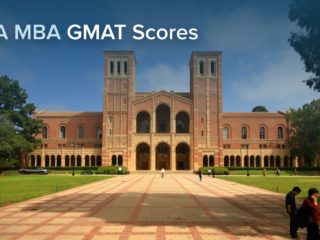| Getting your Trinity Audio player ready... |
Last Updated on May 11, 2025
Located in Ann Arbor, Michigan, the University of Michigan’s Ross School of Business is ranked #12 (tied with two other schools) on U.S. News & World Report’s 2024 list of the Best Business Schools. So, you can probably imagine that MBA admissions at Ross are pretty competitive. In other words, if you’re planning to apply to the Michigan Ross MBA program, you’ll want every aspect of your application to present you in the best possible light, including your GMAT score.
In this article, we’ll look at the University of Michigan MBA class profile, average GMAT scores, and the acceptance rate. We’ll also discuss how to use that data to set a competitive GMAT score goal for Michigan Ross admissions. Additionally, we’ll answer some common questions about the standardized test scores required of aspiring Ross students.
Note that this article focuses on Ross’s full-time MBA program. Ross also offers a few part-time MBA program options, including online MBA, weekend MBA, and Executive MBA programs.
Here are all the topics we’ll cover:
- Does Michigan’s MBA Program Require GMAT Scores?
- Is the GMAT Better Than the GRE for Michigan Ross?
- The Michigan Ross MBA Acceptance Rate
- The Michigan Ross MBA Class Profile
- Ross GMAT Scores
- GMAT Score for Michigan Ross: What Score Do You Need?
- Key Takeaways
- What’s Next?
First, let’s review Ross’s application requirements as they relate to test scores.
Does Michigan’s MBA Program Require GMAT Scores?
The Michigan Ross MBA program allows applicants quite a few options when it comes to submitting test scores. Applicants to Ross’s full-time MBA program are allowed to submit any of GMAT, GRE, LSAT, MCAT, PCAT, or DAT scores.
Note that Ross does allow candidates to self-report unofficial scores with their MBA applications. However, if you are accepted to the program, you will have to provide your official score report. Of course, policies can always change. So, if you plan to submit unofficial scores, first check with the MBA admissions office to confirm that submitting unofficial scores is still permitted.
Note also that international students for whom English is not their native language must submit either a TOEFL, IELTS, or PTE score to demonstrate English proficiency unless the student has an undergraduate degree from an accredited institution where English is the sole language of instruction.
KEY FACT:
Applicants to Ross’s full-time MBA program are allowed to submit any of GMAT, GRE, LSAT, MCAT, PCAT, or DAT scores.
While Ross provides a variety of testing options, it currently reports only GMAT and GRE scores in its class profile. So, it’s probably a pretty safe bet that most Ross applicants submit either a GMAT or a GRE score.
This begs the question: is the GMAT better than the GRE for Michigan MBA applications?
Is the GMAT Better Than the GRE for Michigan Ross?
In response to the question of whether Ross prefers a particular standardized test, Ross states on its website:
“… you are at no advantage or disadvantage by taking one exam instead of the other.”
When a school makes such a statement, there is no reason not to take the school at its word. After all, what would admissions committees gain by not telling prospective students what programs really want? Wouldn’t admissions just be wasting its own time by giving applicants a false impression?
If you’re leaning toward the GRE, you also may be comforted to know that the percentage of applicants submitting GRE scores has remained consistent for the past 5 years, hovering around the average of 34%. Check out the 5-year data below:
Ross GRE Score Submissions: A 5-Year View
| Class Year | 2026 | 2025 | 2024 | 2023 | 2022 |
|---|---|---|---|---|---|
| % of Applicants Submitting GRE | 34 | 36 | 30 | 33 | 37 |
So, if you’re trying to decide between the GMAT and GRE for Ross, I don’t think you have to worry that submitting a GRE score will make you an outlier. Moreover, based on Ross’s own statement, I don’t think you should worry about the school’s having a particular test preference.
You still might feel concerned that taking a particular test will put you at a disadvantage. It never hurts to contact the folks in admissions directly to get their take on the matter. MBA admissions offices are generally more than willing to help with questions that applicants have.
KEY FACT:
The Ross School of Business states on its website that it has no preference for either the GMAT or GRE.
We now understand the MBA program’s standardized test requirement. Let’s take a look at the Michigan Ross acceptance rate.
The Michigan Ross MBA Acceptance Rate
Currently, Michigan’s Ross School does not disclose its acceptance rate on its website. However, reputable sources such as U.S. News & World Report, Forbes and Poets & Quants have reported acceptance rates ranging from 20-37% in the past 5 years. Let’s take a look:
Michigan Ross Acceptance Rate: A 5-Year View
| Class Year | 2026 | 2025 | 2024 | 2023 | 2022 |
|---|---|---|---|---|---|
| Acceptance Rate | 29 | 38 | 28 | 20 | 37 |
You might notice that the acceptance rate decreased by nearly 25% from 2025 to 2026. A hidden factor is that the number of applicants for the class of 2025 was 2,976 versus 4,036 for the class of 2026, which is a 36% increase. Thus, you can infer that Ross was not necessarily more selective for the class of 2026. Rather, there was a significantly greater applicant pool from which to choose. Additionally, there was not a corresponding increase in the number of available slots.
KEY FACT:
The acceptance rate for Ross’s full-time MBA class of 2026 was approximately 29%.
So, what does the incoming class at a selective school such as Ross look like? Let’s review the UM Ross student profile.
The Michigan Ross MBA Class Profile
The Ross MBA class profile is impressive, not only in terms of student achievement but also in terms of diversity. In the space of top MBA programs, Ross students are a fairly diverse bunch. Let’s take a look at some key demographic information for the Ross MBA class for the past few years.
Ross Full-Time MBA Program: Class Demographics 2024-2026
| Class Year | Average UGPA | Average Years of Work Experience | Female | International | U.S. Students of Color |
|---|---|---|---|---|---|
| 2026 | 3.42 | 6.0 | 40% | 44% | 53% |
| 2025 | 3.43 | 5.8 | 43% | 43% | 43% |
| 2024 | 3.5 | 5.6 | 42% | 36% | 42% |
First, we should note that Ross states the following on its website:
“We do not require a specific number of years of work experience prior to entering the Ross MBA program, but almost all incoming Ross students have worked for at least 2 years … historically students with more than 2 years of work experience have been most successful in the full-time MBA program.”
It’s important to keep these statements in mind. While Ross does not specify required minimums for undergraduate GPA, GMAT scores, or work experience, like most other top MBA programs, Ross seems to prefer that its students have a few years of work experience under their belts.
Does that mean you have to hit the 5-year mark in your career to be competitive at Ross? Not necessarily. After all, work experience is just one factor among many that admissions will consider. However, you may want to apply when you can count yourself in that “more than 2 years” category. This will help give you the best possible shot at gaining entry to Ross.
Notable Demographic Shifts
We have already mentioned the record number of applicants for the class of 2026. This 36% increase over the previous year allowed Ross to meet or exceed several key metrics. The average years of work experience increased for the third year in a row. The percentage of international students stayed roughly the same as last year. But there was a significant increase (nearly 25%) in the percentage of U.S. students of color. This metric includes Asian American as well as Black and Hispanic students. The percentage increase in “underrepresented minorities,” which excludes Asian Americans, yielded an even more impressive 52% increase, from 19% to 29%.
Of note is the 7% decrease in the percentage of women in the class of 2026. Ross has seen the lowest percentage of women in an entering class since 2016. Unlike Ross, many other top-25 schools reached or exceeded gender parity in recent years.
KEY FACT:
Several key metrics for the class of 2026 saw significant increases.
Let’s take a look at what Ross students earned their undergraduate degrees in.
Ross MBA Class Profile: Undergraduate Majors
As we can see, the percentages of those with Business and STEM degrees have “flip-flopped” in the past three years. During the same period, the proportion of those with Humanities degrees has stayed constant. It appears that Business and STEM are currently sharing the limelight. This is a stark difference from the classes of 2021 – 2023, where Business was a clear winner.
KEY FACT:
For the past three years, Business and STEM undergraduate degrees have been competing for top position.
Now, let’s have a look at the professional backgrounds of Ross’s full-time MBA class of 2026.
MBA Class of 2026: Top Pre-MBA Industries
As we can see, finance has overtaken consulting as the most common pre-MBA industry for admitted students. This reverses a previous trend for the 3-year period from 2021 to 2023, during which time consulting was the winner.
Of course, both consulting and finance backgrounds are quite common at top MBA programs. But it’s interesting to note the reversal in the number of Ross students hailing from each industry. An interesting side note is that most top business schools consider consulting the most desirable background.
Also note that those with a tech background resoundingly outnumbered those with a health background in the class of 2026. This also reversed a 3-year trend.
KEY FACT:
Finance overtook consulting as the most common pre-MBA industry among Ross students in the class of 2026.
This class profile data will come in handy when we discuss setting your GMAT score goal for your Ross MBA. Before we get to that, let’s take a look at the final piece of the class profile puzzle: GMAT scores.
Ross GMAT Scores
Let’s take a look at Ross MBA average GMAT scores for the past 6 years.
Per the data above, the GMAT average at Michigan Ross’s full-time MBA program appears to be about 720. There are two relative outliers (2022 and 2026). Notably, the post-pandemic class of 2022 had a record-low number of applicants. This could have led to the school’s need to be less selective in admissions that year. In contrast, the class of 2026 had a record-high number of applicants, allowing the school to be more selective.
Now, does that mean that 720 is “the magic number” you should be shooting for when you take your GMAT? You might not be surprised to learn that setting your target GMAT score is a little more complicated than simply looking at the class average. Let’s discuss.
GMAT Score for Michigan Ross: What Score Do You Need?
Generally speaking, a good GMAT score for any MBA program will equal the average GMAT score of admitted students. However, class averages are merely a starting point when you set your GMAT score goal. After all, admissions committees weigh numerous factors when considering each applicant. GPA, work experience, recommendations, personal background, and application essays — all of these elements of your MBA application will come into play, in addition to your standardized test scores.
Thus, a competitive GMAT score for one applicant may not look so great for another. Consider this: the middle 80% GMAT score range for the Ross class of 2026 is 690-760. That range tells us that 80% of students in the class scored in that 70-point range, 10% of the class scored below 690, and 10% scored above 760. All together, the class of 2026 has a pretty wide-ranging set of GMAT scores.
So, you can’t simply assume that the class average is the GMAT score that will make you a competitive applicant. Clearly, many Ross students were admitted with below-average GMAT scores and many had above-average scores. In other words, there is no one “magic number” that opens the door for every applicant. To set your score goal, you need to think like admissions, weighing all of your unique strengths and weaknesses.
To set your score goal, you need to think like admissions, weighing all of your unique strengths and weaknesses.
Setting Your GMAT Score Goal
When setting your target GMAT score, strive to balance your applicant profile. Of course, higher is always great when it comes to the GMAT game. However, you don’t want to neglect other aspects of your application because you’re focused on scoring a 735 (equivalent to a legacy score of 770) you don’t really need.
Ask yourself, are there weaknesses in your applicant profile that your GMAT score could help balance out? For example, perhaps your quant academic background is not particularly strong. In that case, a high GMAT Quant score could help reassure admissions that you can succeed in quant-heavy classes.
Let’s look at some other example scenarios illustrating weighing various aspects of your profile when setting your GMAT score goal.
Scenario 1
Let’s say you’re part of a group (or a few groups) that is overrepresented at Ross. In this case, your application might not stand out. People in groups that are overrepresented in MBA admissions typically need to earn higher GMAT scores in order to get noticed in the sea of similar applicants. For instance, say you’re a white male with an undergraduate degree in business. You have a GPA of 3.6 and about 5 years of work experience in consulting. You can bet that there will likely be plenty of other applicants to Ross with profiles very similar to yours.
Thus, a GMAT score of 720 probably won’t do much to distinguish your application. In other words, if your GMAT score meets the average, then the major aspects of your application will all be, by Ross’s standards, average.
To stand out, a smart strategy would be to shoot for a GMAT score that beats the class average. In the case of our imaginary applicant above, shooting for a score near the top of Ross’s mid-80% range (if not higher) may be advisable, since he falls into several overrepresented or “average” categories.
TTP PRO TIP:
If you are in an overrepresented group, aim for a GMAT score that beats the Ross average, possibly one at the top end of the mid-80% range.
Scenario 2
Let’s say your applicant profile already stands out in some respects. In other words, you’re underrepresented or not “average.” You may be quite competitive applying to Ross with a score at the lower end of the mid-80% range. Of course, only you know just how strong your applicant profile is and whether there are weak points in your application that high test scores could help compensate for.
Moreover, you should keep in mind that top MBA programs typically prefer GMAT Quant scores of 49 or higher. Furthermore, they may not look kindly on GMAT section scores that are wildly imbalanced.
So, even if you are from an underrepresented group, a safe bet would be to aim for a GMAT score that at least meets the Ross average of 720.
TTP PRO TIP:
If you’re in an underrepresented group, aim for a GMAT score that at least meets the Ross average of 720.
Key Takeaways
No matter how your applicant profile stacks up next to the University of Michigan’s Ross MBA profile, the GMAT can be a powerful tool for showing admissions that you have what it takes to excel in a rigorous top 10 MBA program.
Below are some key points to keep in mind when setting your GMAT score goal for Michigan Ross.
- Ask yourself whether there are any weaknesses in your applicant profile that your GMAT score could help balance out.
- People in groups that are overrepresented in MBA admissions typically need to earn higher GMAT scores.
- If you are in an overrepresented group(s), aim for a GMAT score that beats the Ross average. Aim for a score at the top of the mid-80% range, or higher if you have weaknesses in your profile.
- If you are in an underrepresented group, aim for a GMAT score that at least meets the Ross average.
- Top MBA programs typically prefer GMAT Quant scores of 49+, and they like to see fairly balanced section scores.
- The Ross average GMAT score is not a “magic number” for admittance.
Remember, whatever your GMAT score goal, with the right attitude and a smart study plan, you CAN earn the score you need to be competitive at Ross. (A top-notch, personalized GMAT prep course also doesn’t hurt.) Consider the GMAT as another opportunity to showcase your skills, and do everything in your power to seize that opportunity!
Consider the GMAT as another opportunity to showcase your skills, and do everything in your power to seize that opportunity!
What’s Next?
Thinking of applying to other top business schools like Ross? This guide to GMAT scores at top MBA programs can help you get started.
Already know your score goal? Get expert strategies for reaching it with this guide to scoring 700+ on the GMAT.



